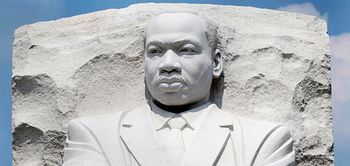From Smithsonian:
 In early August, as the finishing touches are being made to the Martin Luther King, Jr. National Memorial in Washington, D.C., Deryl McKissack waits in a trailer on the premises. “You could not pick a better site,” says the engineer, of the four-acre plot alongside the capital’s Tidal Basin. “He is sitting on a direct axis between the Lincoln and Jefferson memorials—so between two presidents. That is a spot for a king, right?” Surprised by the pun that rolls off of her tongue, McKissack splits into laughter. “I never thought of what it would be like the day of dedication. I always thought about just being a part of something great,” says McKissack, 50, president and CEO of McKissack and McKissack, an architectural and engineering firm. The memorial opens to the public August 22, and the official dedication ceremony is set for August 28. “It is sinking in for me now,” she says. The memorial for King has certainly been a long time in the making. In the mid-1980s, a few members of Alpha Phi Alpha, the oldest intercollegiate fraternity for African Americans, presented the idea to the brotherhood’s board of directors. (King became an Alpha in 1952 while studying theology at Boston University.) It was not until the fall of 1996, though, that the Senate and House of Representatives passed joint resolutions to finally authorize the building of a memorial honoring the civil rights leader. In 1998, President Bill Clinton signed the resolution, and by December 1999, the Martin Luther King, Jr. National Memorial Foundation was accepting design proposals. The foundation’s panel of judges reviewed over 900 designs, submitted by architects, designers and students from 52 countries. Ultimately, an entry by San Francisco’s ROMA Design Group was chosen. From there, the foundation worked tirelessly to secure the memorial’s high-profile site near the National Mall and raise money. In 2006, Chinese sculptor Lei Yixin was selected to be the Sculptor of Record and contribute the centerpiece of ROMA’s design, a statue of King. A year later, McKissack’s involvement became official. Her firm—with Turner Construction, Tompkins Builders and Gilford Corporation—was hired as the design-build team that would take the memorial from concept to reality.
In early August, as the finishing touches are being made to the Martin Luther King, Jr. National Memorial in Washington, D.C., Deryl McKissack waits in a trailer on the premises. “You could not pick a better site,” says the engineer, of the four-acre plot alongside the capital’s Tidal Basin. “He is sitting on a direct axis between the Lincoln and Jefferson memorials—so between two presidents. That is a spot for a king, right?” Surprised by the pun that rolls off of her tongue, McKissack splits into laughter. “I never thought of what it would be like the day of dedication. I always thought about just being a part of something great,” says McKissack, 50, president and CEO of McKissack and McKissack, an architectural and engineering firm. The memorial opens to the public August 22, and the official dedication ceremony is set for August 28. “It is sinking in for me now,” she says. The memorial for King has certainly been a long time in the making. In the mid-1980s, a few members of Alpha Phi Alpha, the oldest intercollegiate fraternity for African Americans, presented the idea to the brotherhood’s board of directors. (King became an Alpha in 1952 while studying theology at Boston University.) It was not until the fall of 1996, though, that the Senate and House of Representatives passed joint resolutions to finally authorize the building of a memorial honoring the civil rights leader. In 1998, President Bill Clinton signed the resolution, and by December 1999, the Martin Luther King, Jr. National Memorial Foundation was accepting design proposals. The foundation’s panel of judges reviewed over 900 designs, submitted by architects, designers and students from 52 countries. Ultimately, an entry by San Francisco’s ROMA Design Group was chosen. From there, the foundation worked tirelessly to secure the memorial’s high-profile site near the National Mall and raise money. In 2006, Chinese sculptor Lei Yixin was selected to be the Sculptor of Record and contribute the centerpiece of ROMA’s design, a statue of King. A year later, McKissack’s involvement became official. Her firm—with Turner Construction, Tompkins Builders and Gilford Corporation—was hired as the design-build team that would take the memorial from concept to reality.
For McKissack, this job is a culmination of work done by generations of her family. Today, she is among the fifth generation in her family to work in construction and architecture. The first generation, Moses McKissack, came to the United States from West Africa in 1790 as a slave and learned the trade of building from his master, William McKissack.
More here.
Mating with Neanderthals and another group of extinct hominids, Denisovans, strengthened the human immune system and left behind evidence in the DNA of people today, according to new research. The findings add to the growing body of evidence that modern humans who left Africa around 65,000 years ago mated with Neanderthals and Denisovans — two archaic species that lived in Europe and Asia. The study, which appears in this week's Science, is among the first to show how the interbreeding shaped modern human genes and the attributes they pass to us.
